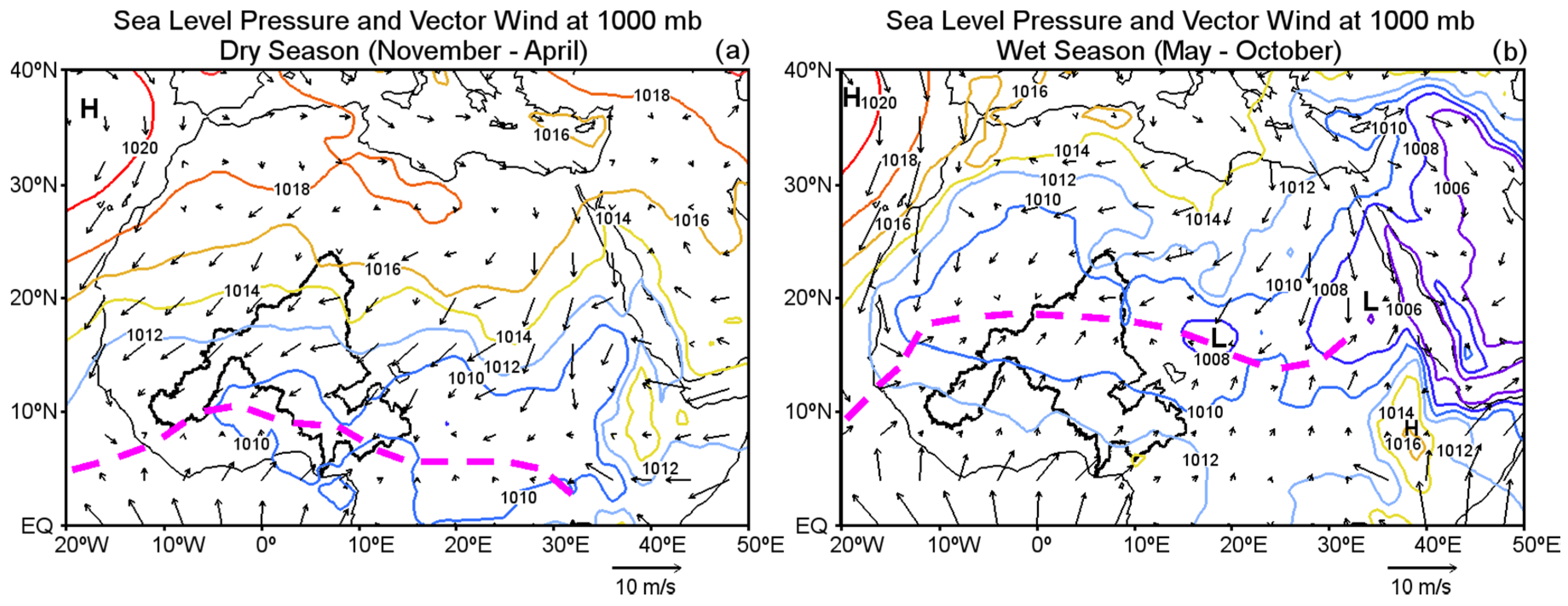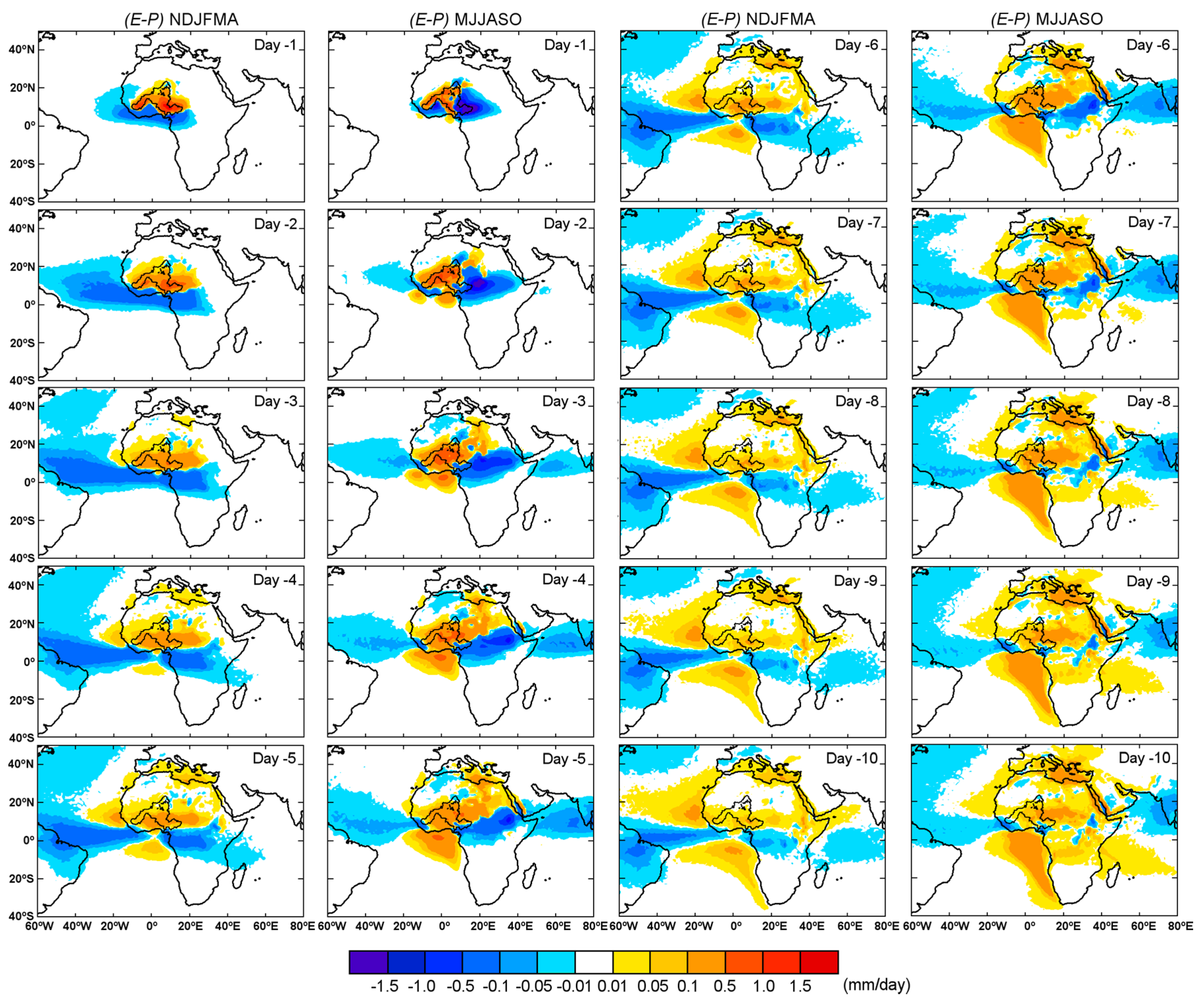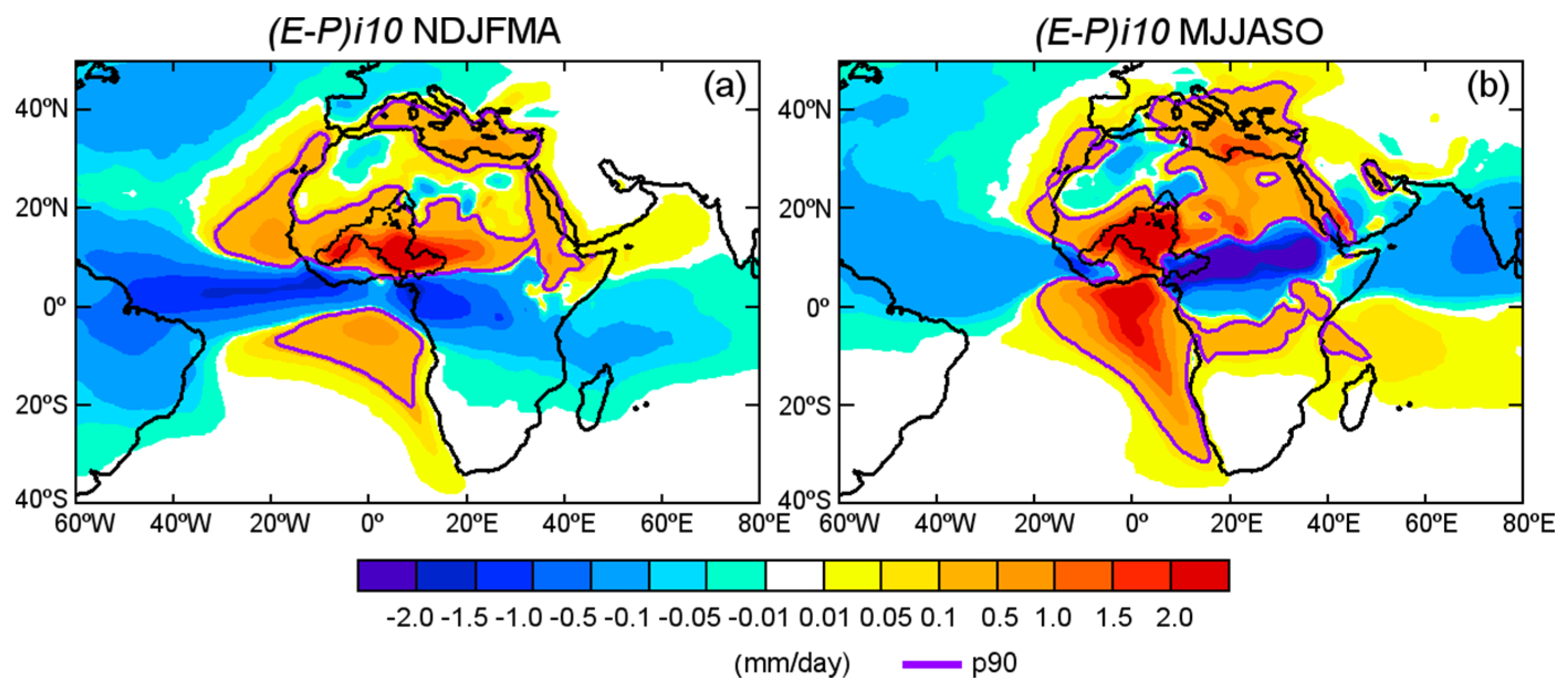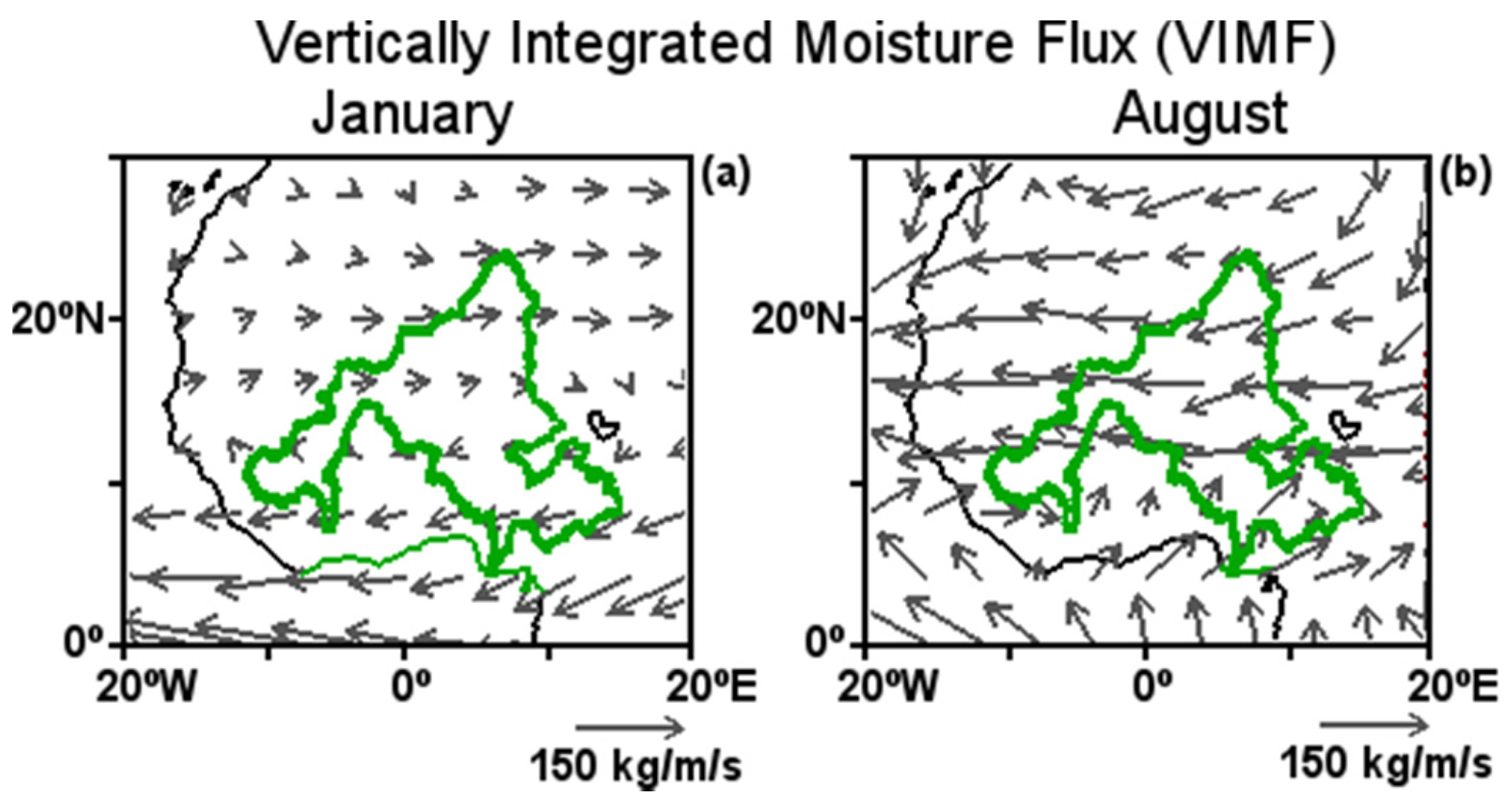The Niger River Basin Moisture Sources: A Lagrangian Analysis
Abstract
:1. Introduction
2. Study Area
3. Experiments Section
3.1. Method
3.2. Data
4. Results and Discussion
4.1. Backward Analysis of (E – P)
4.2. Climatological Moisture Sources Delimitation
4.3. Daily Budget of (E – P) Over the Sources
4.4. Monthly Budget of (E – P)i10 over the Sources and Precipitation in the NRB
4.5. Seasonal (E – P)i10 > 0 over the Sources
5. Conclusions
- The moisture sources for the NRB in both seasons are located in the tropical east North Atlantic Ocean (NAtl), the tropical east South Atlantic Ocean (SAtl), the surrounding Sahel areas, the Mediterranean region (MEDT), and the NRB itself (Figure 5). They experience differences in the spatial extension between the rainy and dry seasons in the NRB.
- The sources appear during NDJFMA, herein termed ESah and EA, seem to join together in MJJASO occupying north-east Africa (NEA). Additionally, during the wet season three moisture sources appear in central equatorial Africa (CEA), the Indian Ocean (Ind), and on the Persian Gulf (Figure 5).
- Computing the budget of (E – P) for the air masses tracked up to 10 days backwards in time from the NRB, it was found that the NRB itself, and the surrounding Sahel regions, are mainly responsible for moisture uptake during the first few days of the backwards analysis confirming, as expected from previous studies, the importance of recycling in this region. Further back in time, SAtl, NAtl, NEA, and MEDT are the most important sources (Figure 3 and Figure 6).
- In the rainy season, together with greater precipitation over the NRB (Figure 7), the (E – P)i10 > 0 values over the NRB itself decrease (Figure 7d and Figure 9b). In these months (May–October) the atmospheric circulation associated with the West African monsoon favours greater moisture transport to the basin from regions located to the north-east, east, and south of the basin (Figure 5b).
- The seasonal moisture uptake quantification over the moisture sources of the NRB, reveals that the largest fraction of moisture income to the basin (69.2% in NDJFMA and 79.7% in MJJASO) comes from outside its boundaries (Figure 9). This finding suggests that precipitation variability over the basin must be governed by the moisture contributions from these sources.
Supplementary Materials
Acknowledgments
Author Contributions
Conflicts of Interest
References
- Gong, C.; Eltahir, E.A.B. Sources of Moisture for Rainfall in West Africa. Water Resour. Res. 1996, 32, 3115–3121. [Google Scholar] [CrossRef]
- Durán-Quesada, A.M.; Gimeno, L.; Amador, J.A.; Nieto, R. Moisture sources for Central America: Identification of moisture sources using a Lagrangian analysis technique. J. Geophys. Res. 2010, 115, D05103. [Google Scholar]
- Gimeno, L.; Stohl, A.; Trigo, R.M.; Dominguez, F.; Yoshimura, K.; Yu, L.; Drumond, A.; Durán-Quesada, A.M.; Nieto, R. Oceanic and terrestrial sources of continental precipitation. Rev. Geophys. 2012, 50, RG4003. [Google Scholar] [CrossRef]
- Druyan, L.M.; Koster, R.D. Sources of Sahel Precipitation for Simulated Drought and Rainy Seasons. J. Clim. 1989, 2, 1438–1446. [Google Scholar] [CrossRef]
- Eltahir, E.A.B.; Bras, R.L. Precipitation recycling. Rev. Geophys. 1996, 34, 367–378. [Google Scholar] [CrossRef]
- Nieto, R.; Gimeno, L.; Trigo, R.M. A Lagrangian identification of major sources of Sahel moisture. Geophys. Res. Lett. 2006, 33, 1–6. [Google Scholar] [CrossRef]
- Dirmeyer, P.A.; Brubaker, K.L.; DelSole, T. Import and export of atmospheric water vapor between nations. J. Hydrol. 2009, 365, 11–22. [Google Scholar] [CrossRef]
- Van der Ent, R.J.; Savenije, H.H.G.; Schaefli, B.; Steele-Dunne, S.C. Origin and fate of atmospheric moisture over continents. Water Resour. Res. 2010, 46, W09525. [Google Scholar] [CrossRef]
- Keys, P.W.; van der Ent, R.J.; Gordon, L.J.; Hoff, H.; Nikoli, R.; Savenije, H.H.G. Analyzing precipitationsheds to understand the vulnerability of rainfall dependent regions. Biogeosciences 2012, 9, 733–746. [Google Scholar] [CrossRef]
- Keys, P.W.; Barnes, E.A.; van der Ent, R.J.; Gordon, L.J. Variability of moisture recycling using a precipitationshed framework. Hydrol. Earth Syst. Sci. 2014, 18, 3937–3950. [Google Scholar] [CrossRef] [Green Version]
- Goessling, H.F.; Reick, C.H. On the “well-mixed” assumption and numerical 2-D tracing of atmospheric moisture, Atmos. Chem. Phys. 2013, 13, 5567–5585. [Google Scholar]
- Arnault, J.; Knoche, R.; Wei, J.; Kunstmann, H. Evaporation tagging and atmospheric water budget analysis with WRF: A regional precipitation recycling study for West Africa. Water Resour. Res. 2016, 52, 1544–1567. [Google Scholar] [CrossRef]
- Stohl, A.; James, P. A Lagrangian analysis of the atmospheric branch of the global water cycle: 2. Earth’s river catchments, ocean basins, and moisture transports between them. J. Hydrometeorol. 2005, 6, 961–984. [Google Scholar] [CrossRef]
- The Center for Ocean-Land-Atmosphere Studies. Available online: http://cola.gmu.edu/wcr/river/Niger.png (accessed on 2 February 2017).
- Liebmann, B.; Blade, I.; Kiladis, G.N.; Carvallo, L.M.V.; Senay, G.B.; Allured, D.; Leroux, S.; Funk, C. Seasonality of African Precipitation from 1996 to 2009. J. Clim. 2011, 25, 4304–4322. [Google Scholar] [CrossRef]
- Biasutti, M.; Yuter, S.E. Observed frequency and intensity of tropical precipitation from instantaneous estimates. J. Geophys. Res. Atmos. 2013, 118, 9534–9551. [Google Scholar] [CrossRef]
- Niang, I.; Ruppel, O.C.; Abdrabo, M.A.; Essel, A.; Lennard, C.; Padgham, J.; Urquhart, P. Africa. In Climate Change 2014: Impacts, Adaptation, and Vulnerability. Part B: Regional Aspects; Contribution of Working Group II to the Fifth Assessment Report of the Intergovernmental Panel on Climate Change; Cambridge University Press: Cambridge, UK, 2014; pp. 1199–1265. [Google Scholar]
- Nicholson, S.E.; Some, B.; Kone, B. An analysis of recent rainfall conditions in West Africa, including the rainy seasons of the 1997 El Nino and the 1998 La Nina years. J. Clim. 2000, 13, 2628–2640. [Google Scholar] [CrossRef]
- Lebel, T.; Ali, A. Recent trends in the Central and Western Sahel rainfall regime (1990–2007). J. Hydrol. 2009, 375, 52–64. [Google Scholar] [CrossRef]
- Huang, J.; Zhang, C.; Prospero, J.M. Large-scale effect of aerosols on precipitation in the West African Monsoon region. Q. J. R. Meteorol. Soc. 2009, 135, 581–594. [Google Scholar] [CrossRef]
- Djebou, D.C.S. Integrated approach to assessing streamflow and precipitation alterations under environmental change: Application in the Niger River Basin. J. Hydrol. Reg. Stud. 2015, 4, 571–582. [Google Scholar] [CrossRef]
- Nicholson, S.E. The West African Sahel: A Review of Recent Studies on the Rainfall Regime and Its Interannual Variability. ISRN Meteorol. 2013, 2013, 1–32. [Google Scholar] [CrossRef]
- The Niger River Basin Authority (NBA). Executive Secretariat P.O.Box 729, Niamey (Niger). Available online: http://www.abn.ne (accessed on 1 November 2016).
- Ogilvie, A.; Mahe, G.; Ward, J.; Serpantie, G.; Lemoalle, J.; Morand, P.; Barbier, B.; Diop, A.T.; Caron, A.; Namara, R.; et al. Water, agriculture and poverty in the Niger River Basin. Water Inter. 2010, 35, 594–622. [Google Scholar] [CrossRef]
- Buontempo, C. Sahelian Climate: Past, Current, Projections; Sahel and Club West Africa Secretariat. Met Office Hadley Centre: London, UK, 2010; pp. 1–20. [Google Scholar]
- L’Hôte, Y.; Mahé, G. Afrique de l’ouest et Centrale. Carte des Precipitations Moyennes Annuelles (Période 1951–1989); Office de la Recherche Scientifique et Technique d’Outre-Mer (ORSTOM): Paris, France, 1996. (In French) [Google Scholar]
- Andersen, I.; Dione, O.; Jarosewich-Holder, M.; Olivry, J.-C. The Niger River Basin: A Vision for Sustainable Management; World Bank: Washington, DC, USA, 2005. [Google Scholar]
- Van der Ent, R.J. A New View on the Hydrological Cycle over Continents. Ph.D. Thesis, Delft University of Technology, Delft, The Netherlands, 2014. [Google Scholar]
- Nicholson, S. On the question of the “recovery” of the rains in the West African Sahel. J. Arid Environ. 2005, 63, 615–641. [Google Scholar] [CrossRef]
- Knippertz, P.; Andreas, H.F. Dry-Season Precipitation in Tropical West Africa and Its Relation to Forcing from the Extratropics. Mon. Weather Rev. 2008, 136, 3579–3596. [Google Scholar] [CrossRef]
- Lavaysse, C.; Flamant, C.; Janicot, S.; Parker, D.J.; Lafore, J.-P.; Sultan, B.; Pelon, J. Seasonal evolution of the West African heat low: A climatological perspective. Clim. Dyn. 2009, 33, 313–330. [Google Scholar] [CrossRef]
- Lavaysse, C.; Flamant, C.; Evan, A.; Janicot, S.; Gaetani, M. Recent climatological trend of the Saharan heat low and its impact on the West African climate. Clim. Dyn. 2015. [Google Scholar] [CrossRef] [Green Version]
- Sultan, B.; Janicot, S. The West African Monsoon Dynamics. Part II: The “Preonset” and “Onset” of the Summer Monsoon. J. Clim. 2003, 16, 3407–3427. [Google Scholar] [CrossRef]
- Namara, R.E.; Barry, B.; Owusu, E.S.; Ogilvie, A. An Overview of the Development Challenges and Constraints of the Niger Basin and Possible Intervention Strategies; IWMI Working Paper 144; International Water Management Institute: Colombo, Sri Lanka, 2011; pp. 1–34. [Google Scholar] [CrossRef]
- Zhang, C.; Woodworth, P.; Gu, G. The seasonal cycle in the lower troposphere over West Africa from sounding observations. Q. J. R. Meteorol. Soc. 2006, 132, 2559–2582. [Google Scholar] [CrossRef]
- Stohl, A.; James, P. A Lagrangian analysis of the atmospheric branch of the global water cycle. Part 1: Method description, validation, and demonstration for the August 2002 flooding in central Europe. J. Hydrometeorol. 2004, 5, 656–678. [Google Scholar] [CrossRef]
- Numaguti, A. Origin and recycling processes of precipitating water over the Eurasian continent: Experiments using an atmospheric general circulation model. J. Geophys. Res. 1999, 104, 1957–1972. [Google Scholar] [CrossRef]
- Salih, A.A.M.; Zhang, Q.; Tjernström, M. Lagrangian tracing of Sahelian Sudan moisture sources. J. Geophys. Res. Atmos. 2015, 120, 6793–6808. [Google Scholar] [CrossRef]
- Nieto, R.; Gallego, D.; Trigo, R.M.; Ribera, P.; Gimeno, L. Dynamic identification of moisture sources in the Orinoco basin in equatorial South America. Hydrol. Sci. J. 2008, 53, 602–617. [Google Scholar] [CrossRef]
- Drumond, A.; Nieto, R.; Gimeno, L. Sources of moisture for China and their variations during drier and wetter conditions in 2000–2004: A Lagrangian approach. Clim. Res. 2011, 50, 215–225. [Google Scholar] [CrossRef]
- Drumond, A.; Marengo, J.; Ambrizzi, T.; Nieto, R.; Moreira, L.; Gimeno, L. The role of the Amazon Basin moisture in the atmospheric branch of the hydrological cycle: A Lagrangian analysis. Hydrol. Earth Syst. Sci. 2014, 18, 2577–2598. [Google Scholar] [CrossRef] [Green Version]
- Nieto, R.; Castillo, R.; Drumond, A.; Gimeno, L. A catalog of moisture sources for continental climatic regions. Water Resour. Res. 2014, 50, 5322–5328. [Google Scholar] [CrossRef]
- Drumond, A.; Taboada, E.; Nieto, R.; Gimeno, L.; Vicente-Serrano, S.M.; López-Moreno, J.I. A Lagrangian analysis of the present-day sources of moisture for major ice-core sites. Earth Syst. Dynam. 2016, 7, 549–558. [Google Scholar] [CrossRef]
- Drumond, A.; Nieto, R.; Gimeno, L. A Lagrangian approach for investigating anomalies in the moisture transport during drought episodes. Cuad. Investig. Geogr. 2016, 42, 113–125. [Google Scholar] [CrossRef]
- Dee, D.P.; Uppala, S.M.; Simmons, A.J.; Berrisford, P.; Poli, P.; Kobayashi, S.; Andrae, U.; Balmaseda, M.A.; Balsamo, G.; Bauer, P.; et al. The ERA-Interim reanalysis: Configuration and performance of the data assimilation system. Q. J. R. Meteorol. Soc. 2011, 137, 553–597. [Google Scholar] [CrossRef]
- Harris, I.; Jones, P.D.; Osborn, T.J.; Lister, D.H. Updated high-resolution grids of monthly climatic observations—The CRU TS3.10 Dataset. Int. J. Climatol. 2014, 34, 623–642. [Google Scholar] [CrossRef] [Green Version]
- Schicker, I.; Radanovics, S.; Seibert, P. Origin and transport of Mediterranean moisture and air. Atmos. Chem. Phys. 2010, 10, 5089–5105. [Google Scholar] [CrossRef]
- Levine, R.C.; Turner, A.G. Dependence of Indian monsoon rainfall on moisture fluxes across the Arabian Sea and the impact of coupled model sea surface temperature biases. Clim. Dyn. 2012, 38, 2167–2190. [Google Scholar] [CrossRef]
- Drumond, A.; Nieto, R.; Hernandez, E.; Gimeno, L. A Lagrangian analysis of the variation in moisture sources related to drier and wetter conditions in regions around the Mediterranean Basin. Nat. Hazards Earth Syst. Sci. 2011, 11, 2307–2320. [Google Scholar] [CrossRef] [Green Version]
- Lélé, M.I.; Leslie, L.M.; Lam, P.J. Analysis of Low-Level Atmospheric Moisture Transport Associated with the West African Monsoon. J. Clim. 2015, 28, 4414–4430. [Google Scholar] [CrossRef]









© 2017 by the authors. Licensee MDPI, Basel, Switzerland. This article is an open access article distributed under the terms and conditions of the Creative Commons Attribution (CC BY) license ( http://creativecommons.org/licenses/by/4.0/).
Share and Cite
Sorí, R.; Nieto, R.; Drumond, A.; Gimeno, L. The Niger River Basin Moisture Sources: A Lagrangian Analysis. Atmosphere 2017, 8, 38. https://doi.org/10.3390/atmos8020038
Sorí R, Nieto R, Drumond A, Gimeno L. The Niger River Basin Moisture Sources: A Lagrangian Analysis. Atmosphere. 2017; 8(2):38. https://doi.org/10.3390/atmos8020038
Chicago/Turabian StyleSorí, Rogert, Raquel Nieto, Anita Drumond, and Luis Gimeno. 2017. "The Niger River Basin Moisture Sources: A Lagrangian Analysis" Atmosphere 8, no. 2: 38. https://doi.org/10.3390/atmos8020038








